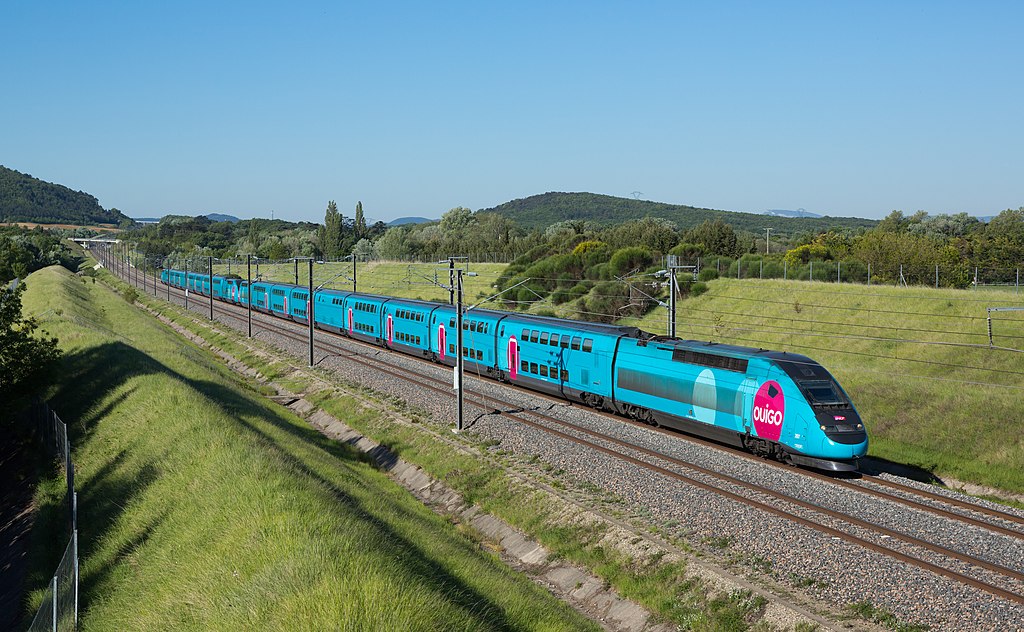Last Updated on: 7th December 2023, 07:58 am
Take the fast track to French savings with Ouigo, an affordable high-speed rail option spreading across Europe.
Created by France’s railway SNCF in 2013 as a discount TGV service for cost-conscious travelers, Ouigo offers fares from just €5 to popular destinations within metropolitan France and beyond.
This should come in handy for lots of budget travelers, as regular TGV rides are expensive.
Let’s see how you can travel by high-speed train in Europe for cheap with Ouigo.

Kabelleger / David Gubler, CC BY-SA 4.0 <https://creativecommons.org/licenses/by-sa/4.0>, via Wikimedia Commons
Main Topics of Ouigo: France’s High-Speed Budget Rail Option
What is Ouigo?
Ouigo is a French discount high-speed rail service operated by the national railway company SNCF.
Introduced in 2013, Ouigo offers cheap tickets on TGV trains to various destinations across France. I don’t know of any other low cost high-speed rail service in Europe or in any other place for that matter.
How Comes Ouigo Rides Are So Cheap?
There are a few main reasons why Ouigo is able to offer cheap high-speed rail tickets:
- Streamlined service model: By eliminating onboard catering, assigned seats, and customer service staff at stations, Ouigo significantly reduces its operating costs compared to traditional TGV services. This low-cost model is deliberately similar to low-cost airlines.
- High train usage: Ouigo minimizes downtime at stations by standardized turnarounds in 25 minutes. The trains spend more time on tour making revenue trips rather than sitting idle, improving cost efficiency.
- Special carriages: Ouigo uses dedicated double-decker TGV Duplex trainsets offering 25% more capacity than normal TGVs. More seats to sell allows lowering ticket costs per passenger.
- Demand generation: Ouigo has attracted new demographics who didn’t use conventional TGVs before due to the prices. The service has tapped budget-conscious travelers including students and families.
- Distribution differences: Where traditional operators rely on agents, over 80% of Ouigo tickets are sold via online channels, bypassing third-party commissions and fees. Automated e-tickets also reduce expenses.
Essentially, Ouigo has adapted techniques used by low-cost airlines and lean manufacturing to design and optimize train travel for affordability. Have you ever imagined 30 years ago that the day would come when you’d be able to fly across Europe for pennies?
By rethinking 116 years of French rail service assumptions, Ouigo has delivered remarkable savings benefiting millions of passengers so far.
Where to Buy Ouigo Tickets
Tickets can be purchased directly online through Ouigo’s booking portal with fares starting as low as €5 in off-peak hours. They also partner with third party sites for bookings.
The online channels are cheap, as they eliminate the need for third-party businesses taking a profit cut, and therefore adding to the price to consumer.
Destinations Across France and Europe
Ouigo serves over 30 stations within metropolitan France including Paris, Lyon, Marseille, Nice and Toulouse, along with major connecting stations like Charles de Gaulle Airport.
Recently they have expanded internationally to Spain, Italy and Germany as well with new routes planned to London and Belgium.
Saving with Limited Service
Operating as a low-frills airline model adapted to rail, Ouigo eliminates onboard catering and cuts down on station staff to reduce expenses. By forgoing assigned seating and streamlining turnaround times, Ouigo achieves higher use of expensive high-speed train sets to also save costs.
Can You Buy Food on Ouigo Train?
As mentioned above, there’s no catering on Ouigo trains.
Bring your own food and drink even when you board for a longer ride such as Paris – Marseille or Paris – Nice.
Diverse Seating Options
In line with the budget airline service style, Ouigo offers different classes of fares. Besides standard Ouigo class with rows of reclining seats, Ouigo+ tickets include foldout tray tables and power outlets.
Ouigo Intégrale grants first class seating in dedicated coaches for the ultimate in comfort.
Ouigo Class
This is the standard budget class on Ouigo trains with rows of fixed reclining blue seats. The 3×2 seating configuration means middles seats have less shoulder space. Ouigo class does not include power outlets or tray tables, with snacks and beverages available for purchase from roaming carts. It’s ideal for short journeys under 2 hours where maximizing savings is the priority.
Ouigo+ Class
For a small upgrade fee, Ouigo+ class offers various amenities for improved comfort on longer trips. While still fixed reclining seats, there is increased leg and shoulder room.That’s very important to me, as I usually like to do seated leg exercises while traveling.
Tray tables fold out and electrical outlets are available at every seat to power devices and electronics. With reading lights above each seat, the brighter interior finishes reduce eye strain.
It can be worth upgrading for journeys over 3 hours. For shorter rides, you may be fine with the basic class coach.
Ouigo Intégrale Class
This premium seating grants access to the designated first class coaches, with swiveling recliners in a spacious 2×1 layout.
Large tables, individual reading lamps, and easily accessible electric outlets are standard. Free snacks, beverages, and onboard entertainment like WiFi and streaming films are also included. For ultimate comfort on lengthy trips across France, Ouigo Intégrale class surrounds you in refinement – all while still saving over standard TGV first class ticket prices.
How To Track which Coach Your Seat Is Located on
Tracking the coach position on the train is easy.
- Check your ticket/e-ticket confirmation – This will clearly list your coach number along with seat number. Ouigo trains typically have between 8-10 coaches.
- Look for signage at stations – Digital displays and printed signs will note which coach on the incoming Ouigo train aligns with each section of the platform. Letter indicators count from the front, with Coach A right behind the locomotive all the way through to the final coach.
- Know seating class differences РAs covered previously, Ouigo Int̩grale first-class coaches are always positioned at the front, followed by Ouigo+ coaches, with budget Ouigo class coaches making up middle and rear positions. Interior color schemes also differentiate classes.
- Locate coach access points – Doors for boarding are located throughout the length of the distinctively blue double-decker Ouigo trains. Match the coach letter/number on your ticket to the marking over the door to directly access your coach.
- Seek conductor guidance – If still uncertain, ask any Ouigo personnel in their trademark neon uniforms. Train conductors can also assist with finding seats if needed.
With some basic indications distinguishing coaches between first class, upgraded class, and budget class zones, navigating an Ouigo train becomes fast and friendly for even first-time riders.
What Is the English Translation of Ouigo?
There are two approaches to the acronym for this low cost high-speed European rail.
Oui means Yes in French. We can literally translate Ouigo from France to English as “yes, go!”
On the other hand, “oui” and “we” share a similar pronunciation. Therefore, the meaning of Ouigo in English could be “we go.”
Why Ouigo?
In just a few years, Ouigo has transformed the landscape of high-speed rail in France and now across Europe.
By adapting the cost-efficient approach of low-cost airlines to the rails, Ouigo has made lightning-quick TGV train trips affordable for millions more travelers. With online ticketing, stripped-back amenities, and airline-style seating options catering to different budgets, Ouigo offers the right fit for diverse riders.
As the service expands to serve over a dozen countries soon, the company shows no signs of braking from revolutionizing access to convenient, sustainable national and international rail connections.I can’t wait to see it coming to Romania as well.
- Dingli Cliffs: How To Visit Malta’s Highest Point - April 24, 2024
- Blue Grotto Malta - April 23, 2024
- Ramla Beach Gozo, Maybe the Best in Malta - April 9, 2024

